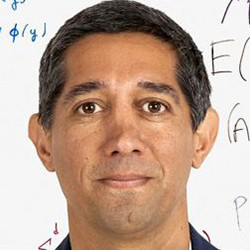October 21, 2022
How to prove the unprovable with AI
Evolutionary AI’s quantification power has wide-ranging application for product design, marketing and anything that would benefit from empirical interpretation of data.
Beauty, it is often said, is in the eye of the beholder. It is a subjective concept that means something different to different people. But what if we could collect the views of many different people to come up with a quantifiable determination of what beauty actually is? Or, going further, what if we could use this new measure of beauty to design in ways that exceed our imagination?
We can, using Evolutionary AI. While AI is well-established for driving process automation, businesses are increasingly discovering it can also play a key role in judging, designing and creating—activities in which the human perspective is often biased by values, experiences and desires.
Evolutionary AI, on the other hand, simply seeks out the “most fit” outcome. The process might be harsh and the results surprising, but they are likely far more fair, measurable and accurate than what humans can produce.
For example, Picbreeder is an online community that leverages an AI technology called interactive evolutionary computation (IEC) to create images universally deemed beautiful. Images are “evolved” by participants selecting desirable images, which serve as “parents.” These images spawn a new generation of images as different as possible from their ancestors, which are then selected by other members of this community. Through this input, the graphics evolve in appeal, creativity and complexity, using an evolutionary optimization process.
The same approach of using evolutionary optimization and empirical measurement can be applied to improving operational performance, tracking R&D progress, detecting cyber fraud, identifying optimal product placement or analyzing and interpreting medical diagnostic information—all of which are now dependent on some level of subjective interpretation of data.
Quantifying the previously unquantifiable
Consider how many measures today are based on human interpretation. For example, the stock market can lose or gain hundreds of billions of dollars in value overnight based on how traders infer some new piece of information. Is it possible that market measurements can change this much in a blink of time? Or is it all at the mercy of traders’ fears, ambitions and the limitations of the calculations?
Similarly, selling products with subjective outcomes to customers has always posed a problem for business. How do you create proof points against a competitor with a subpar product but superior marketing or distribution capabilities? How do the R&D folks know when they’ve actually improved the product design? For example, we are told that a new car has a smoother ride. But how do you measure “smooth?” How does it compare? By how much?
This is why Evolutionary AI has broad potential application today—fueled by the collection of massive amounts of data, which increasingly requires sophisticated algorithms to help analysts make sense of it. Applying Evolutionary AI to quantify the subjective could have broad implications for business, science, education and other aspects of society. It will evolve (if not transform) how companies design, build, sell and market their products.
A true test: measuring facial age
Consider facial recognition. In the human realm, the ability to rapidly interpret facial characteristics is key to social interaction. As an evolutionary feature, it was necessary for survival, as it was used to identify parents, siblings and tribe members.
But while virtually everyone can interpret another person’s face, that ability is highly subjective. Not without controversy, AI has been used to help measure facial recognition, whether it be for social media or security purposes. It could also help in medicine, to detect changes in facial features for stroke victims or patients afflicted with palsy, or to detect changes in the aging process.
Interpreting facial characteristics is of particular concern to Abbvie, the maker of Botox. In the half-trillion-dollar cosmetic and beauty business, how faces look is important. And Botox is expensive. So how can Abbvie demonstrate that these injections do what they assert, which is make their customers look younger? Or, to put it another way, how do they quantify the subjective?
We worked with Abbvie to do just this, using our Learning Evolutionary AI Framework (LEAF) technology. The main idea was to “train” neural networks, using facial images as the dataset, to generate a quantifiable measure of patient age.
To test this measure, one group of patients was given a placebo injection, while the other two groups were given different versions of the active injectable treatment. The neural network was then used to estimate the patients’ age before the treatment and at several times up to 180 days after the injection.
The test generated a quantifiable result: Patients with active treatment appeared consistently chronologically younger than those with placebo injections. The system was able to identify the age within two years on average, and roughly twice as accurately as humans.
Beyond facial recognition, the important finding here is that by using Evolutionary AI, we can measure what has previously been only an opinion. This will help companies empirically measure operational performance, track R&D progress while providing customers with greater knowledge and gain more confidence in the value of their product purchases.
Prove it with Evolutionary AI
The demonstrated capabilities of these models point to promising applications for business. Using Evolutionary AI, large numbers of possible strategies can be generated and evaluated for any particular scenario.
The power of these new models is that they are not constrained by past methods or biased by preconceived notions. Like natural selection itself, Evolutionary AI introduces creative, and unanticipated, changes that enable decision makers to assess outcomes that had previously not been considered.
Using Evolutionary AI, businesses can tackle previously intractable problems, identify unanticipated opportunities and become fit for the future.
Babak Hodjat is VP of Evolutionary AI at Cognizant and former co-founder & CEO of Sentient. He is responsible for the technology behind the world’s largest distributed AI system and was the founder of the world's first AI-driven hedge fund.
Babak.Hodjat@cognizant.comRisto Miikkulainen is AVP of Evolutionary AI at Cognizant and a Professor of Computer Science. His current research focuses on methods and applications of neuroevolution, and neural network models of natural language processing and vision.
risto.miikkulainen@cognizant.comLatest posts
Related posts
Subscribe for more and stay relevant
The Modern Business newsletter delivers monthly insights to help your business adapt, evolve, and respond—as if on intuition



